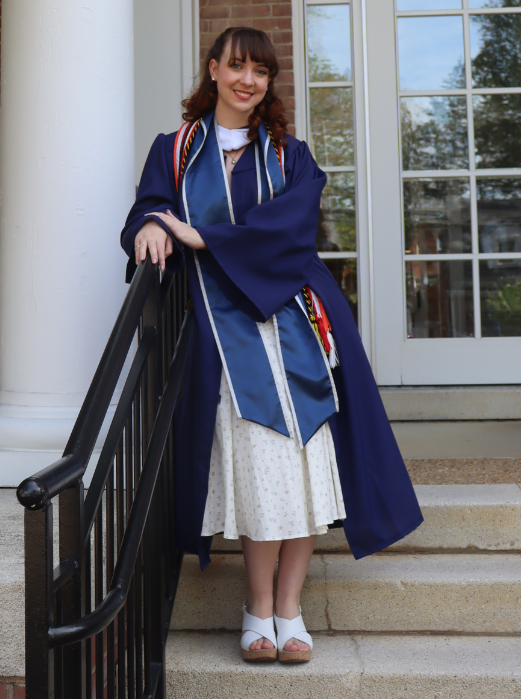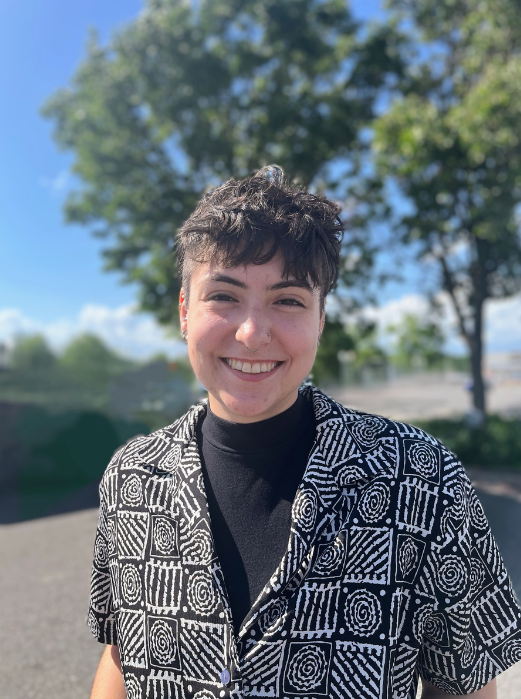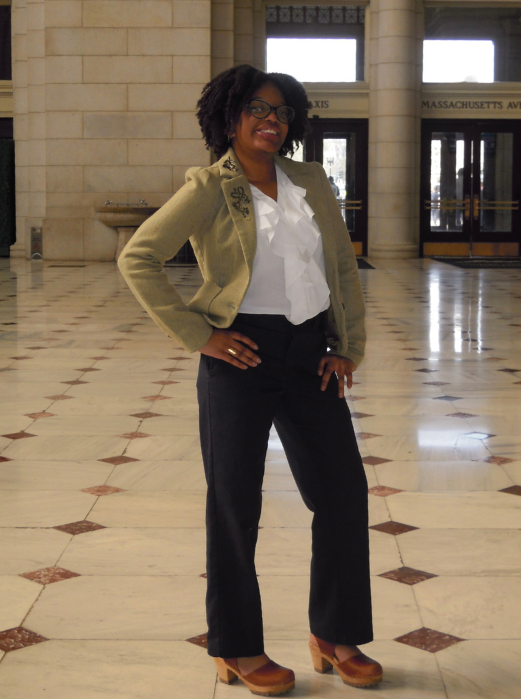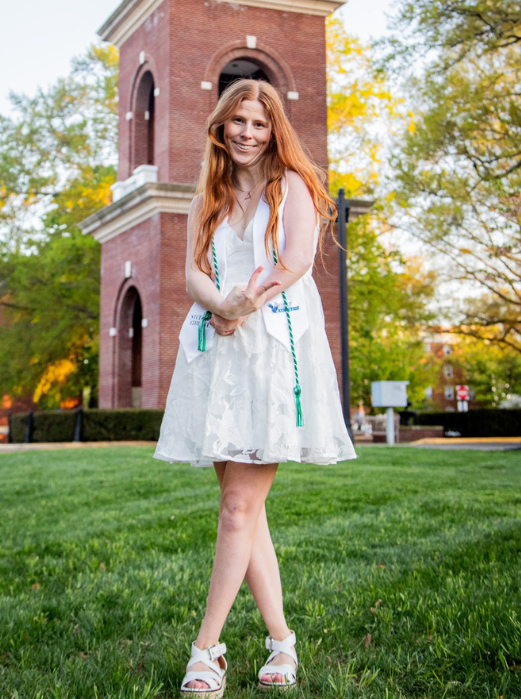This page features the 2025 class of Honors in Communication and Digital Studies. To earn this recognition, these students graduated their degree with a minimum 3.7 GPA in their major and completed a capstone project worthy of distinction as a CDS honors project.

Layla McGovern
“Gibble-Gabble: A Digital Literary Blog”
Class: COMM 491
Sponsor: Lindley Estes-Thomas
Abstract
Gibble-Gabble is a digital literary blog offering sanctuary for readers who appreciate intellectually challenging literature. This project delivers diverse content through video essays, opinion pieces, listicles, book recommendations, and photojournalism, establishing a unique space that blends formal academic analysis with magazine-style journalism. Gibble-Gabble’s voice is distinctive, as it is more substantive than typical blogs yet more palatable than scholarly writing. Gibble-Gabble engages thoughtfully with classics and contemporary works with merit while critiquing online trends, including vapid romance novels, unsustainable “book haul” overconsumption, and declining literary standards through self-publishing on social media. Gibble-Gabble’s unique voice combines formal writing elements with snarky commentary, building authenticity and credibility with readers. Although Gibble-Gabble initially aimed toward English students and academics missing traditional pedagogical discussions, the blog has evolved into an accessible platform for anyone passionate about the artistic merit of literature. Plans for Gibble-Gabble include regular posting and expanding social media outreach to connect with readers disillusioned with current literary trends.

Bella Molseed
“Girl Math,” “Girl Dinner,” and “24 Year Old Teenage Girl”: Young Female Identity Construction Through Language
Class: COMM 460
Sponsor: Elizabeth Johnson-Young
Abstract
This paper analyzes the use of the phrase “just a girl” on the social media platform TikTok through a feminist rhetorical lens to understand how female identity is being constructed and defined by the young women who use the phrase. By analyzing fourteen videos using the phrase “just a girl,” this paper identifies themes of incompetence, innovation, vanity, and overconsumption. The phrase functions similarly to the phrase “boys will be boys” by infantilizing the people being described while assigning specific behaviors to gender. Men are expected to be dangerous and violent, while women are expected to be incompetent and vapid. The usage of these phrases support negative stereotypes and assumptions about gender, which then uphold hegemonic gender norms that culturally support violence against women. However, the use of the phrase “just a girl” can also be seen as a rejection of unachievable standards placed on women in contemporary society.

Duncan Bowles
“Human Creativity and AI: A survey of student attitudes about AI in the classroom”
Class: DGST 491
Sponsor: J.D. Swerzenski
Abstract
AI is an influential and growing concept, especially within modern education. This research plans to find students’ opinions of AI within a classroom or college major setting, but I am specifically looking at it through a creative lens. Conducting two separate focus groups, consisting of two other individuals, I asked participants tailored questions regarding their thoughts on AI, hoping to find out whether they believe AI can help or damage their work within their specific major. The majors that were chosen consisted of Media Production and Studio Art, two sides that are majorly impacted by the presence of AI in different ways. As AI advances with the development of new enhanced programs, it’s interesting to see how opinions will shift in each respective major. For better or for worse, AI is something that will become an even more mainstream thing within the near future, so this research captures a small portion of that present stance.

Madison Fry
“True Crime: Desensitized by Social Media Video Creators?”
Class: COMM 460
Sponsor: Adria Goldman
Abstract
This article explores the impact of True Crime content on social media platforms, particularly TikTok, and its potential to desensitize viewers to real-life crimes. The study uses a content analysis method by examining comments on True Crime TikTok videos to understand viewer reactions and responses. The research addresses a gap in existing literature, primarily focusing on True Crime podcasts and other media forms, by investigating the phenomenon on social media platforms popular among younger generations. The paper analyzes 60 comments from 10 True Crime TikTok videos, categorizing them based on their content and focus. The study aims to determine whether the consumption of True Crime content on social media leads to desensitization towards criminal acts in America. This research contributes to understanding how new media formats and platforms shape public perception and emotional responses to crime-related content.

Greta Hammen
“Rhetoric, Diets, and Deception: Analyzing Advertising Strategies”
Class: COMM 460
Sponsor: Adria Goldman
Abstract
Advertising for diet foods and plans frequently uses persuasive rhetoric to appeal to diverse audiences. The promise of rapid results or lifestyle transformations is at the heart of the advertisements. This paper examines the rhetorical strategies used in diet advertising, focusing on their use of ethos, pathos, and logos to establish credibility, evoke emotions, and present logical arguments. It investigates how these advertisements often exploit misinformation to influence consumer behavior, by using exaggerated claims. By analyzing examples from digital and traditional media, this study discloses patterns in how advertisers shape their messages to target specific demographics. A case study from the Communicating Health Project in Australia is included to demonstrate how participants with varying lifestyles and attitudes toward diet interpreted health messaging differently. The findings highlight these strategies’ ethical concerns and their impact on public health. This research contributes to a deeper understanding of how language and persuasion in diet advertising influence perceptions of health and wellness.

Katie Reif
“The Plastic Purge”
Class: DGST 491
Sponsor: J.D. Swerzenski
Abstract

Rylie Vann
“I Won’t Accept this Rose: ‘The Bachelor(ette),’ Gender Stereotypes, and Self-perception”
Class: COMM 491
Sponsor: Adria Goldman
Abstract
Reality television is a cornerstone of modern-day TV programming, and typically features some element of competition, a makeover, or finding love. The Bachelor began airing in 2002, and the franchise that was built off the initial season continues to be a big name in romantically themed reality television. However, the show employs a variety of tactics during filming and while editing that presents a heteronormative view of contestants. The extent of this influence was explored using a mixed-method approach. A content analysis of several episodes from The Bachelor and The Bachelorette was conducted in order to determine how many instances of gender-based stereotyping occur on the show. Following this, a survey was created to see if casual viewers of the show noticed these choices, as well as inquiring if this messaging impacted the way they perceive themselves and their role in a relationship.

Aaron Dawson
“Women Draw Women Better: How The Hypersexualization Of Women And Reinforcement Of Sexist Tropes In The Comic Book Industry Has Shifted”
Class: COMM 460
Sponsor: Emily Crosby
Abstract

Martina Nicholson
“Influencer or fake, it’s all one in the same on TikTok”
Class: COMM 460
Sponsor: Adria Goldman
Abstract
How brands market their product has changed with the rise of social media. TikTok has become one of the largest platforms for brands to find their consumer base. This is because TikTok is a source of entertainment that has been able to co-opt marketing movements that introduce the aspect of brand and viewer relationship based on identity. When a viewer is able to establish an identity with the brand, they become an active consumer. Brands are able to do this through the influencers, which has become the new norm within marketing strategy. Influencers are able to gain a following due to their personalities on social media. Despite its success, this strategy can often result in a disjunction between viewer and brand, when the line between general content and marketing starts to blur. This happens when brands begin using influencers or rhetoric from influencers to gain audience attention.

Caroline Conner
“TikTok’s Perception of Volunteer Tourism in the Global South”
Class: COMM 460
Sponsor: Adria Goldman
Abstract
This study explores the portrayal of volunteer tourism (voluntourism) in the Global South on TikTok and focuses on the ethical implications of how these experiences are perceived on social media. Volunteer tourism offers an affordable way for individuals to travel while engaging in volunteer work in exchange for housing and food. However, these opportunities can sometimes have unintended negative consequences for host communities. Through a qualitative and quantitative content analysis, the study identifies recurring themes such as child exploitation, moral superiority, and the defamation of host countries. Majority of posts were found to adopt a “mirroring” perspective, portraying voluntourism as universally beneficial, while overlooking the potential harm caused by volunteers. This study highlights the need for a more honest approach to the portrayal of volunteer tourism on social media, emphasizing the importance of responsible posting and ethical reflection in volunteer practices and their digital documentation.

Blaise Wingold
“Sesame Street: From Puppets to Pixels”
Class: COMM 460
Sponsor: Emily Crosby
Abstract
Sesame Street has been around since 1969 and is still creating new episodes to this day. The program was created by Joan Ganz Cooney in an attempt to use television to educated and entertain children simultaneously. The show set out goals to create smarter, kinder, and stronger kids. It uniquely featured a diverse cast and was targeted towards disadvantaged youth. However the world has changed a lot since 1969. In this research I use a qualitative content analysis to determine how exactly the show has evolved and adapted to target today’s children verses the children in 1969. Additionally the paper hypothesizes reasons why the show has needed to shift and argue for the preservation of PBS, a network threatened with budget cuts.

Cora Denny
“Advertising to Children: A Content Analysis of Ryan’s World”
Class: COMM 460
Sponsor: Adria Goldman
Abstract
Ryan’s World is a children’s toy review YouTube channel with over 36 million followers and features kid YouTuber Ryan Kaji. A qualitative content analysis of the YouTube channel Ryan’s World was conducted to observe the rhetorical strategies the videos employ to sell Ryan’s World products, as well as how those strategies compare to traditional advertising. An analysis of twelve videos resulted in dominant themes of increasing brand familiarity and product performance of Ryan’s World products. These were accomplished through the use of traditional advertising rhetorical strategies such as product placement, special effects, appeals, and more. The study shows that the rhetorical strategies employed in Ryan’s World mimic the rhetorical strategies in traditional advertising. It also examines how advertising to children has moved to a more covert format, where it is harder, if not impossible, for children to distinguish the persuasive intent behind the messaging.

Amanda Sheward
“Riding the Digital Wave: How Large Enterprises Are Embracing Disability Inclusion in the Digital Era”
Class: COMM 460
Sponsor: Emily Crosby
Abstract
In today’s world, companies increasingly use disability inclusion within their branding and marketing strategies. This research examines whether these efforts represent authentic commitment or merely use the disability community for performative purposes. Using both a content analysis of social media campaigns and a quantitative survey of individuals with physical or cognitive disabilities, this study investigates perceptions of corporate disability narratives. Findings reveal that while some companies, such as Microsoft and Nike, are seen as making genuine connections with the disabled community, many others fall short, engaging only in surface-level inclusion without systemic change. The study highlights a persistent gap between visibility and authentic inclusion, calling on businesses to embed accessibility and genuine representation into their marketing strategies. These insights contribute to ongoing conversations around disability advocacy, corporate ethics, and the future of inclusive branding in the digital age. The research also underscores the importance of involving disabled voices in both campaign creation and evaluation.

Zoe Hanrahan
“Examining the Success of QAnon”
Class: COMM 460
Sponsor: Emily Crosby
Abstract
Rhetorical criticism was used to explore the rhetorical techniques that aid in the dissemination and belief in QAnon, a political conspiracy theory that originally centered around former President Donald Trump. Several practices have made the spread of its ideas remarkably effective. The anonymity of QAnon’s source prevents questioning, making it harder to disprove, and the support of politicians increases its perceived truthfulness. Multimedia coverage, especially on mainstream social media platforms, spreads the beliefs to a wide audience. Vague language leaves the messages open to interpretation and allows supporters to craft narratives around the messages and build a shared community. Additionally, its content parallels Christianity, providing familiarity, purpose, and identity to its supporters. Further anti-conspiracy theory messaging often does not change their views, and since belief in QAnon and other conspiracy theories has led to criminal activities, understanding how the theory spreads might help counter its effects (Jolley & Douglas, 2017).